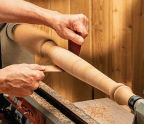Ginkgo Leaf Table

Although it’s my original design, the inspiration for this ginkgo leaf table draws heavily from Japanese influence. Tapered elements that are wider at the base, and rafter-like members that project through legs and posts, are common in Japanese designs — in both furniture and architecture. Other elements of the table, such as the solid panels with leaf cutouts, are reminiscent of Dutch designs dating back hundreds of years. I found that this table’s angled joinery makes it both a joy and a challenge to build.
Mine is constructed from solid walnut lumber. If you’re fortunate enough to have 8/4 stock available, you can simply cut the legs from a plank of walnut. My best-looking stock was only ⅞" thick, so I laminated leg blanks from two strips of wood. Rip eight strips of walnut 1¾" wide, and glue them together in pairs to make four legs. Once the glue cures, flatten and plane them to a finished size of 15⁄8" square by about 19½" long (the legs will be trimmed to final length later).
You’re reading a preview, subscribe to read more.
Start your free 30 days



